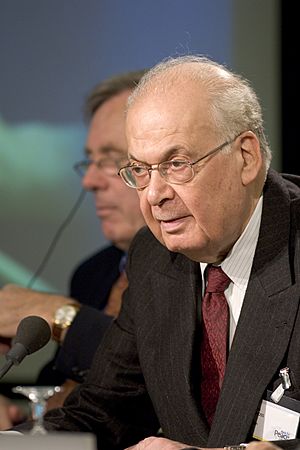Salim Al-Huss facts for kids
Quick facts for kids
Salim al-Huss
|
|
|---|---|
|
سليم الحص
|
|

Al-Huss in 2005
|
|
| 34th Prime Minister of Lebanon | |
| In office 8 December 1976 – 20 July 1980 |
|
| President | Elias Sarkis |
| Preceded by | Rashid Karami |
| Succeeded by | Takieddin el-Solh |
| In office 2 June 1987 – 24 December 1990* |
|
| President |
See list
|
| Preceded by | Rashid Karami |
| Succeeded by | Omar Karami |
| In office 6 December 1998 – 23 October 2000 |
|
| President | Émile Lahoud |
| Preceded by | Rafic Hariri |
| Succeeded by | Rafic Hariri |
| Acting President of Lebanon | |
| In office 24 September 1988 – 5 November 1989* |
|
| Prime Minister | Himself |
| Preceded by | Amine Gemayel |
| Succeeded by | René Moawad |
| In office 22 November 1989 – 24 November 1989* |
|
| Prime Minister | Himself |
| Preceded by | René Moawad |
| Succeeded by | Elias Hrawi |
| Personal details | |
| Born |
Salim Ahmad al-Huss
20 December 1929 Beirut, Greater Lebanon |
| Died | 25 August 2024 (aged 94) |
| Spouse |
Leila Pharaoun
(died 1990) |
| Children | 1 |
| Alma mater | American University of Beirut Indiana University Bloomington |
| *Al-Huss's term was disputed between 22 September 1988 and 13 October 1990 by Michel Aoun. | |
Salim Ahmad al-Huss (Arabic: سليم أحمد الحص, romanized: Salīm ʾAḥmad al-Ḥuṣṣ; 20 December 1929 – 25 August 2024), also known as Selim El-Hoss, was an important politician from Lebanon. He served as the Prime Minister of Lebanon four times. He was also a Member of Parliament for many years, representing his home city, Beirut. People often called him a technocrat, meaning he was known for using his knowledge and skills to solve problems in government.
Contents
Early Life and Education
Salim al-Huss was born in Beirut, Lebanon, on 20 December 1929. He came from a Sunni Muslim family.
He studied economics at the American University of Beirut. Later, he earned a PhD in business and economics from Indiana University in the United States.
Al-Huss was married to Leila Pharaoun. She was a Maronite Christian who later converted to Islam. This allowed her to be buried next to her husband in a Muslim cemetery.
Political Career Highlights
Salim al-Huss served as the Prime Minister of Lebanon four times. His time in office often happened during difficult periods for the country.
His first term was from 1976 to 1980, at the start of the Lebanese Civil War. His second term, from 1987 to 1989, was quite challenging. During this time, he was recognized by many countries as the Prime Minister.
He served a third time from November 1989 to December 1990. This was after Elias Hrawi became president. His final term as Prime Minister was from December 1998 to October 2000.
Later Roles and Retirement
In 2000, al-Huss lost his seat in Parliament during the general elections. After this, he decided to step down as Prime Minister. He announced that he was ending his political career.
In March 2005, he was asked to form a new government. However, he declined the offer due to health reasons.
During his last two terms as Prime Minister, he also held the position of Foreign Minister. This meant he was in charge of Lebanon's relationships with other countries.
Al-Huss was against the death penalty. While he was Prime Minister, he refused to sign any execution orders. This temporarily stopped executions in Lebanon.
A Time of Two Governments
From January to September 1988, Salim al-Huss did not attend his own cabinet meetings. He was protesting against the policies of President Amine Gemayel. On 22 September, he refused to accept being removed from his position. This was because General Michel Aoun, a Maronite Christian, was appointed instead.
The problem started because the Parliament could not agree on a new president. The Lebanese constitution says that if there is no president, the outgoing president can appoint a temporary prime minister to act as president. President Gemayel chose Michel Aoun for this role. However, the position of prime minister was traditionally held by a Sunni Muslim.
Al-Huss did not accept Aoun as prime minister. This led to Lebanon having two rival governments. Aoun worked from the presidential palace in Baabda. Al-Huss set up his own office in West Beirut, which was mostly Muslim.
This meant Lebanon had no official president and two governments. Syria, which occupied parts of Lebanon at the time, supported al-Huss. Many international countries dealt with both governments. They recognized both as prime ministers, even though Aoun was constitutionally the acting president.
Conflict soon broke out between the two leaders. Michel Aoun did not want Syrian troops in Lebanon. Al-Huss remained acting president from 1988 until 5 November 1989. Then, René Moawad became president. When Moawad was killed 17 days later, al-Huss again acted as president for two days. After that, Elias Hrawi was elected president.
In 1990, the civil war ended. Aoun was forced to surrender after an attack on the presidential palace. This attack was carried out by Syrian and Lebanese military forces. After this, al-Huss resigned as prime minister. Omar Karami took over the role.
Later Years and Passing
On 2 May 2017, when he was 87 years old, al-Huss took part in a one-day hunger strike. He did this to show support for about 1,500 Palestinian prisoners who were on a hunger strike.
Salim Hoss passed away on 25 August 2024, at the age of 94.
Images for kids
See also
 In Spanish: Selim al-Hoss para niños
In Spanish: Selim al-Hoss para niños


